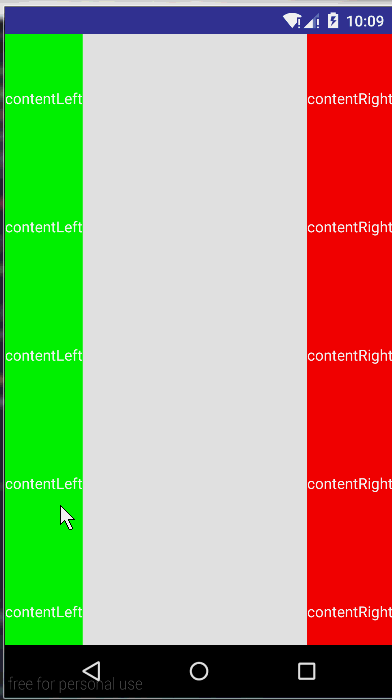CoordinatorLayout高级用法-自定义Behavior
在新的support design中,CoordinatorLayout可以说是最重要的一个控件了,CoordinatorLayout给我们带来了一种新的事件的处理方式——behavior,你是不是还记得我们在使用CoordinatorLayout的时候,一些子view需要一段,
app:layout_behavior="@string/appbar_scrolling_view_behavior"这样的xml配置?当时我们不知道这是干嘛的,直接照用就行了,后来发现这玩意是一个类!而且我们还可以自定义!所以,今天这篇博客我们首先来学习一下如何自定义Behavior,之后的博客可能会看一下CoordinatorLayout是怎么处理这个Behavior的。
认识Behavior
Behavior是CoordinatorLayout的一个抽象内部类
public abstract static class Behavior<V extends View> {
public Behavior() {
}
public Behavior(Context context, AttributeSet attrs) {
}
...
}有一个泛型是指定的我们应用这个Behavior的View的类型,例如上面的appbar_scrolling_view_behavior对应的字符串其实是android.support.design.widget.AppBarLayout$ScrollingViewBehavior,这个ScrollingViewBehavior内部类指定的泛型是View,所以理论上这个Behavior我们任何的View都可以使用,我们在自定义的时候,如果不是特殊的行为,也可以直接指定泛型View。
在自定义Behavior的时候,我们需要关心的两组四个方法,为什么分为两组呢?看一下下面两种情况
- 某个view监听另一个view的状态变化,例如大小、位置、显示状态等
- 某个view监听CoordinatorLayout里的滑动状态
对于第一种情况,我们关心的是:
layoutDependsOn和onDependentViewChanged方法,
对于第二种情况,我们关心的是:
onStartNestedScroll和onNestedPreScroll方法。
对于这几个方法什么意思,我们需要干什么,稍候我们就能了解到。
初步自定义
现在我们就来根据第一种情况尝试自定义一个Behavior,这里我们实现一个简单的效果,让一个View根据另一个View上下移动。
首先我们来自定义一个Behavior,起名为DependentBehavior
public class DependentBehavior extends CoordinatorLayout.Behavior<View> {
public DependentBehavior(Context context, AttributeSet attrs) {
super(context, attrs);
}
@Override
public boolean layoutDependsOn(CoordinatorLayout parent, View child, View dependency) {
return super.layoutDependsOn(parent, child, dependency);
}
@Override
public boolean onDependentViewChanged(CoordinatorLayout parent, View child, View dependency) {
ViewCompat.offsetLeftAndRight();
return super.onDependentViewChanged(parent, child, dependency);
}
}注意一下,带有参数的这个构造必须要重载,因为在CoordinatorLayout里利用反射去获取这个Behavior的时候就是拿的这个构造。我们覆写了两个方法layoutDependsOn和onDependentViewChanged,这两个方法的参数都是一样的,解释一下,第一个不用说,就是当前的CoordinatorLayout,第二个参数是我们设置这个Behavior的View,第三个是我们关心的那个View。如何知道关心的哪个呢?layoutDependsOn的返回值决定了一切!
这里我们关心一个TextView好了,所以layoutDependsOn可以这么写,
@Override
public boolean layoutDependsOn(CoordinatorLayout parent, View child, View dependency) {
return dependency instanceof TextView;
}现在设置好了关心谁,接下来就是在这个View状态发生变化的时候,我们现在的View该做些什么了,恩,这里肯定是在onDependentViewChanged做工作了。我们的任务就是获取dependency距离底部的距离,并且设置给child,很简单。
@Override
public boolean onDependentViewChanged(CoordinatorLayout parent, View child, View dependency) {
int offset = dependency.getTop() - child.getTop();
ViewCompat.offsetTopAndBottom(child, offset);
return true;
}首先我们先获取两个View的top值的差,然后让child的位置位移一下就ok啦,如此简单,那这个简单的Behavior如何用呢?
<android.support.design.widget.CoordinatorLayout xmlns:android="http://schemas.android.com/apk/res/android" xmlns:app="http://schemas.android.com/apk/res-auto" xmlns:tools="http://schemas.android.com/tools" android:layout_width="match_parent" android:layout_height="match_parent" android:fitsSystemWindows="true" tools:context="org.loader.mybehavior.MainActivity">
<TextView android:id="@+id/depentent" android:layout_width="100dp" android:layout_height="100dp" android:background="#FFFF0000" android:gravity="center" android:textColor="@android:color/white" android:layout_gravity="top|left" android:text="depentent"/>
<TextView android:layout_width="100dp" android:layout_height="100dp" android:background="#FF00FF00" android:gravity="center" android:textColor="@android:color/white" android:layout_gravity="top|right" app:layout_behavior="org.loader.mybehavior.DependentBehavior" android:text="auto"/>
</android.support.design.widget.CoordinatorLayout>注意,第二个TextView我们设置了app:layout_behavior="org.loader.mybehavior.DependentBehavior"
值正好是我们定义的那个DependentBehavior。
final TextView depentent = (TextView) findViewById(R.id.depentent);
depentent.setOnClickListener(new View.OnClickListener() {
@Override
public void onClick(View v) {
ViewCompat.offsetTopAndBottom(v, 5);
}
});在Activity中,我们每次点击第一个TextView都会去改变一下它的位置,下面让我们来看看另一个TextView的位置改变了没有。
Scroll Behavior
在学会了如何自定义Behavior后,我们接着来实现上面说的第二种情况-滑动。为了演示这种Behavior的定义,我们还是来做个无用功,让一个ScrollView跟随另一个ScrollView滑动。恩,先来看看效果吧,
从效果中我们可以看出,第二个ScrollView明显是是在跟随第一个进行滑动,现在就让我们用自定义Behavior的形式实现它。
创建一个Behavior,起名叫ScrollBehavior,
public class ScrollBehavior extends CoordinatorLayout.Behavior<View> {
public ScrollBehavior(Context context, AttributeSet attrs) {
super(context, attrs);
}
@Override
public boolean onStartNestedScroll(CoordinatorLayout coordinatorLayout, View child, View directTargetChild, View target, int nestedScrollAxes) {
return super.onStartNestedScroll(coordinatorLayout, child, directTargetChild, target, nestedScrollAxes);
}
@Override
public void onNestedPreScroll(CoordinatorLayout coordinatorLayout, View child, View target, int dx, int dy, int[] consumed) {
super.onNestedPreScroll(coordinatorLayout, child, target, dx, dy, consumed);
}
@Override
public boolean onNestedPreFling(CoordinatorLayout coordinatorLayout, View child, View target, float velocityX, float velocityY) {
return super.onNestedPreFling(coordinatorLayout, child, target, velocityX, velocityY);
}
}和你想的一样,我们覆写了onStartNestedScroll和onNestedPreScroll方法,但是除了这两个方法外,我们还覆写了onNestedPreFling方法,这个方法是干嘛的? 估计大家已经猜出来了,这里是处理fling动作的,你想想,我们在滑动松开手的时候,ScrollView是不是还继续滑动一会,那我们也需要让跟随的那个ScrollView也要继续滑动一会,这种效果,onNestedPreFling就派上用场了。
好,接下来我们来实现代码,首先来看看onStartNestedScroll,这里的返回值表明这次滑动我们要不要关心,我们要关心什么样的滑动?当然是y轴方向上的。
@Override
public boolean onStartNestedScroll(CoordinatorLayout coordinatorLayout, View child, View directTargetChild, View target, int nestedScrollAxes) {
return (nestedScrollAxes & ViewCompat.SCROLL_AXIS_VERTICAL) != 0;
}现在我们准备好了关心的滑动事件了,那如何让它滑动起来呢?还是要看onNestedPreScroll的实现
@Override
public void onNestedPreScroll(CoordinatorLayout coordinatorLayout, View child, View target, int dx, int dy, int[] consumed) {
super.onNestedPreScroll(coordinatorLayout, child, target, dx, dy, consumed);
int leftScrolled = target.getScrollY();
child.setScrollY(leftScrolled);
}也很简单,让child的scrollY的值等于目标的scrollY的值就ok啦,那fling呢?更简单,
@Override
public boolean onNestedFling(CoordinatorLayout coordinatorLayout, View child, View target, float velocityX, float velocityY, boolean consumed) {
((NestedScrollView) child).fling((int)velocityY);
return true;
}直接将现在的y轴上的速度传递传递给child,让他fling起来就ok了。
定义好了Behavior,就得在xml中使用了,使用方法和前面的一样。
<?xml version="1.0" encoding="utf-8"?>
<android.support.design.widget.CoordinatorLayout xmlns:android="http://schemas.android.com/apk/res/android" xmlns:app="http://schemas.android.com/apk/res-auto" android:layout_width="match_parent" android:layout_height="match_parent" android:fitsSystemWindows="true" android:orientation="vertical">
<android.support.v4.widget.NestedScrollView android:layout_gravity="left" android:layout_width="wrap_content" android:background="#FF00FF00" android:layout_height="match_parent">
<LinearLayout android:layout_width="wrap_content" android:layout_height="wrap_content" android:orientation="vertical">
<TextView android:layout_width="wrap_content" android:layout_height="wrap_content" android:paddingTop="50dp" android:paddingBottom="50dp" android:textColor="@android:color/white" android:text="contentLeft"/>
<TextView android:layout_width="wrap_content" android:layout_height="wrap_content" android:paddingTop="50dp" android:paddingBottom="50dp" android:textColor="@android:color/white" android:text="contentLeft"/>
<TextView android:layout_width="wrap_content" android:layout_height="wrap_content" android:paddingTop="50dp" android:paddingBottom="50dp" android:textColor="@android:color/white" android:text="contentLeft"/>
<TextView android:layout_width="wrap_content" android:layout_height="wrap_content" android:paddingTop="50dp" android:paddingBottom="50dp" android:textColor="@android:color/white" android:text="contentLeft"/>
<TextView android:layout_width="wrap_content" android:layout_height="wrap_content" android:paddingTop="50dp" android:paddingBottom="50dp" android:textColor="@android:color/white" android:text="contentLeft"/>
<TextView android:layout_width="wrap_content" android:layout_height="wrap_content" android:paddingTop="50dp" android:paddingBottom="50dp" android:textColor="@android:color/white" android:text="contentLeft"/>
</LinearLayout>
</android.support.v4.widget.NestedScrollView>
<android.support.v4.widget.NestedScrollView android:layout_gravity="right" android:layout_width="wrap_content" android:background="#FFFF0000" android:layout_height="match_parent" app:layout_behavior="org.loader.mybehavior.ScrollBehavior">
<LinearLayout android:layout_width="wrap_content" android:layout_height="wrap_content" android:orientation="vertical">
<TextView android:layout_width="wrap_content" android:layout_height="wrap_content" android:paddingTop="50dp" android:paddingBottom="50dp" android:textColor="@android:color/white" android:text="contentRight"/>
<TextView android:layout_width="wrap_content" android:layout_height="wrap_content" android:paddingTop="50dp" android:paddingBottom="50dp" android:textColor="@android:color/white" android:text="contentRight"/>
<TextView android:layout_width="wrap_content" android:layout_height="wrap_content" android:paddingTop="50dp" android:paddingBottom="50dp" android:textColor="@android:color/white" android:text="contentRight"/>
<TextView android:layout_width="wrap_content" android:layout_height="wrap_content" android:paddingTop="50dp" android:paddingBottom="50dp" android:textColor="@android:color/white" android:text="contentRight"/>
<TextView android:layout_width="wrap_content" android:layout_height="wrap_content" android:paddingTop="50dp" android:paddingBottom="50dp" android:textColor="@android:color/white" android:text="contentRight"/>
<TextView android:layout_width="wrap_content" android:layout_height="wrap_content" android:paddingTop="50dp" android:paddingBottom="50dp" android:textColor="@android:color/white" android:text="contentRight"/>
</LinearLayout>
</android.support.v4.widget.NestedScrollView>
</android.support.design.widget.CoordinatorLayout>第二个ScrollView的layout_behavior我们指定为org.loader.mybehavior.ScrollBehavior,现在就可以看到上面的效果了。
ok, 最后是文章中demo的代码下载:http://download.csdn.net/detail/qibin0506/9352989

